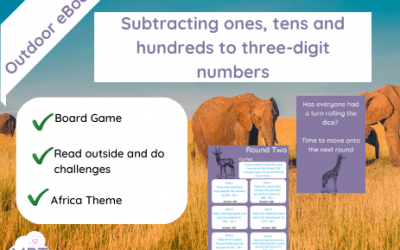Build up early orienteering skills with this Autumn theme pack. Five Reasons Going Outdoors Helps with Children's...
KS2 Adding ones, tens and hundreds to three-digit numbers
Sep 20, 2021
KS2 Adding ones, tens and hundreds to three-digit numbers Why should every good teacher take their learning...
KS2 Subtracting ones, tens and hundreds to three-digit numbers
Sep 20, 2021
Me and my Vitiligo (Outdoor eBook Diversity Range)
Sep 15, 2021
Me and my Vitiligo (Outdoor eBook Diversity Range) ⇒Use Me and my Vitiligo (Outdoor eBook Diversity Range) to take...
(Letter for Parents) Bring a Stick to School Day
Sep 14, 2021
Letter to Parents - Bring a Stick to School Day Letter sample: This year we're embracing the 'Bring A Stick To School...
Compass Skills
Sep 14, 2021
Compass Skills: KS1 Geography ⇒Use the Compass Skills Lesson Plan to take Geography outside in its rightful place!...
Chase me Chase me Outdoor Phonics Game (Ph2 Set5)
Sep 14, 2021
Muddy Phonics Range: Chase me, Chase me Outdoor Phonics Game (Phase Two Set Five) ⇒Use the Chase me, Chase me...
Chase me Chase me Outdoor Phonics Game (Ph2 Set4)
Sep 14, 2021
Muddy Phonics Range: Chase me, Chase me Outdoor Phonics Game (Phase Two Set Four) ⇒Use the Chase me, Chase me...
Chase me Chase me Outdoor Phonics Game (Ph2 Set3)
Sep 14, 2021
Outdoor Phonics: Enhancing Early Literacy through Nature-Based Learning Phonics is an essential component of early...
Chase me Chase me Outdoor Phonics Game (Ph2 Set2)
Sep 14, 2021
Muddy Phonics Range: Chase me, Chase me Outdoor Phonics Game (Phase Two Set Two) ⇒Use the Chase me, Chase me...
Chase me Chase me Phonics Game (Ph2 Set1)
Sep 13, 2021
Chase Me, Chase Me: A Phonic Game by The Muddy Puddle Teacher Phonics is a crucial component of early literacy,...
Mud Kitchen: Spring Silly Soup Range
Sep 10, 2021
Mud Kitchen: Spring Silly Soup Range ⇒Use the Mud Kitchen: Spring Soup from the Silly Soup range to help implement a...
Mud Kitchen: Happy Herb Silly Soup
Sep 10, 2021
Mud Kitchen: Happy Herbs Silly Soup Range ⇒Use the Mud Kitchen: Happy Herbs Soup from the Silly Soup range to help...
Muddy Kitchen: Marvellous Mud Soup Range
Sep 10, 2021
The Benefits of Mud Kitchens: Unleashing Creativity and Learning in Children Mud kitchens have become a popular...
Mud Kitchen: Dippy Dino Silly Soup Recipe
Sep 10, 2021
Mud Kitchen: Dippy Dino Silly Soup Range ⇒Use the Mud Kitchen: Dippy Dino Soup from the Silly Soup range to help...
Mud Kitchen: Cracking Conker Silly Soup Recipe
Sep 10, 2021
Mud Kitchen: Cracking Conker Soup ⇒Use the Mud Kitchen: Cracking Conker Soup from the Silly Soup range to help...
Wishful Walking
Sep 8, 2021
Wellbeing: Wishful Walking ⇒Use the Wishful Walking Lesson Plan to help children clear their minds and learn to calm...
Shade Slumbers (Wellbeing)
Sep 8, 2021
Wellbeing: Shade Slumbers ⇒Use the Shade Slumbers Activities to help children use the most simple gifts of nature to...
New In

Guy Fawkes Early Years – Significant Characters

Guy Fawkes KS1 & Significant People

Guy Fawkes KS2 Timelines

Arrays Year 1 – Hooray for arrays!

Addition & subtraction problems – Calculations challenge

2-digit number (addition and subtraction)

Niggly Number Lines up to 100

Number bonds to 10 – Lanyard Limbo

Ordering numbers up to 1000 – Leave it to the lanyards




















